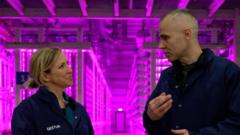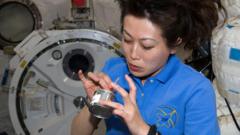In the heart of Iceland, beneath the shadow of the country's largest geothermal power station, an unusual farming operation is taking place. Vaxa Technologies has created a high-tech indoor farm that cultivates microalgae, illuminating its warehouse with an otherworldly pink-purple glow. This innovative approach to food production, as explained by General Manager Kristinn Haflidason, represents "a new way of thinking" about sustainable nutrition.
Historically, humans have relied on macroalgae, or seaweed, but microalgae have been largely overlooked despite their potential benefits. Ancient civilizations in Central America and Africa consumed these nutritional powerhouses, and now modern scientists and entrepreneurs are rediscovering their viability as a food source. Located about 35 minutes from Reykjavik, Vaxa specializes in growing Nannochloropsis microalgae for human consumption and for aquaculture, alongside Arthospira, commonly known as spirulina, which serves as a dietary supplement and food coloring.
These microorganisms perform photosynthesis, capturing sunlight to absorb carbon dioxide and emitting oxygen, leading to what's known as a carbon-negative production process. "The algae is eating CO2, or turning the CO2 into biomass," Haflidason explains. Vaxa enjoys a unique advantage by being the only algae farm integrated with a geothermal power plant, which provides renewable electricity, a consistent supply of cold and hot water, and channels carbon emissions into the production cycle.
Asger Munch Smidt-Jensen, a food technology consultant at the Danish Technology Institute, highlights that Vaxa's operation has a minimal carbon footprint, representing a low land and water requirement. He notes, however, that replicating this model elsewhere is challenging due to the high energy demands of artificial lighting necessary for the growth of the microalgae.
At the facility, the lights buzz constantly, simulating sunlight via a spectrum of red and blue LEDs, a method that maximizes the photosynthesis process. Vaxa utilizes advanced machine learning to optimize the growing conditions, and they manage to harvest about 7% of the crop daily. With the ability to produce 150 metric tons of algae annually, expansion plans are already in the pipeline.
Rich in essential nutrients like protein, omega-3 fatty acids, and vitamin B12, microalgae could be integral in addressing global food shortages. The market for microalgae is projected to grow significantly, likely reaching $25.4 billion by 2033. Other companies, such as Danish startup Algiecel, are experimenting with portable modules that can connect to carbon-heavy industries to utilize their emissions in algae cultivation.
Vaxa's vision extends beyond food, as microalgae have applications in cosmetics, pharmaceuticals, and biofuels. There's even research into cultivating microalgae on the International Space Station, funded by the European Space Agency, showing the vast potential of this sustainable option.
Yet, challenges remain before microalgae become mainstream on dinner plates. Texture and taste are significant barriers, with many varieties carrying an unappealing fishy flavor. Food scientist Malene Lihme Olsen emphasizes the need for further research into digestibility and ways to incorporate microalgae into everyday foods, such as pasta or bread.
During my visit, I witness the unappealing but promising green sludge, the harvested microalgae waiting for processing. Despite initial hesitance, I sample this “green sludge,” finding the flavor neutral, reminiscent of tofu. Emphasizing that they aren't promoting the consumption of the raw product, Mr. Haflidason assures, “We’re just gonna change the nutritional value of the foods that you eat,” with local shops already incorporating spirulina into bakery items and gym smoothies. In a world grappling with food insecurity, the potential of microalgae offers a glimmer of hope for the future of sustainable eating.






















